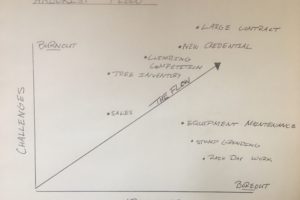The potential for building creative anchor points presents itself often in tree work. Namely, in situations when the tree to be worked is unsafe and cannot handle the forces that climbing and rigging present. There are many options to consider, both creative and efficient. But in these complex systems, it’s important to understand the moving parts, and any potential danger that building them creates. Therefore, you can safely benefit from the work position or rigging points that alternative anchors create.
Of course there is the option of a crane. Crane work is a very popular technique in modern arboriculture. For now I believe that crane assisted tree work is a topic lent all to itself, so I’ll skip that option for this article.
Alternative trees nearby, floating anchors built from multiple rope systems with surrounding trees, conveniently located buildings and/or structures, extension/orchard ladders, vehicles and utility machines, and I’m sure there are dozens of other ways that arborists have created colorful anchors for working on a compensated tree, or even on rough terrain. The rigging plates and hubs and pulleys that exist on today’s market can handle complex combinations of ropes and carabiners.
Remember though that many of these alternative rope and rigging systems will create tremendous amounts of force in ways that maybe we don’t typically experience in a simple climbing system set in the crown we are working. Rope angles get flatter or wider or steeper and vector forces change throughout the system. These systems, because they are larger and more inclusive, are exposed to more variables. Especially in floating anchor systems, it’s very important to consider how different trees will be loaded and if the chosen suspension points (branch unions) can handle those vector forces. Inspect everything that will be included in the system, even if it must be done aerially, and consider how loading the rope will affect the anchor and/or suspension points. Chances are the gear can take it, but can the bio-mechanics of the tree or combination of trees?
Also consider the fact that alternative anchors are necessary mostly in dangerous situations where trees are compensated. These trees can either not be anchored to for climbing, or cannot handle the forces that rigging off that tree will create. Sometimes there is a perfect tree nearby that offers a wonderful rope angle for working, and a sturdy structure for rigging. But in other situations, options like that dwindle. You need to work with longer spans of rope, and create more tension to capture the rope angle and hardware position required for the work. Dynamics are different. Sometimes there are many smaller pieces making up a climbing or rigging system. And although they are fragile individually, together they create something strong enough to handle the load. Do not make a dangerous situation more dangerous.
Of course, there it is not easy business deeming a situation workable or unworkable. Possible or not possible. It is best left to vision of the experienced, and the creativity of cautious. Remember that there is always a safe option. Sometimes that will require large amounts of gear, and sometimes it will require walking away from a situation that you can’t handle. Great arborists should always know the difference.






Leave a Reply
Your email is safe with us.